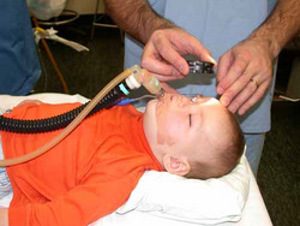Bilateral RB

If there is a history of retinoblastoma in more than one member of a family, then affected members have Familial RB, whether the condition was present in one or both eyes.
If you had retinoblastoma in childhood, then there is also a risk that your children may develop Familial RB. If you had Unilateral Sporadic RB, then the risk is in the order of 5% for each child. If you had Bilateral Sporadic or Familial RB, then the risk is close to 50%, that is, nearly half of your children will develop RB.
Genetic Counselling
One of the most important issues for patients who have survived RB, is appropriate genetic counselling prior to commencing a family. When you were diagnosed with RB in childhood, your parents may have had genetic counselling, but it is vital that you also receive updated and appropriate advice from an experienced clinical geneticist. Your general practitioner or eye doctor will be able to put you in contact with a clinical geneticist in your area.
 Examination Under Anaesthesia (EUA)
Examination Under Anaesthesia (EUA)
Whether you had Unilateral or Bilateral RB, your newborn child’s eyes will need to be examined under a general anaesthetic (EUA) very soon after birth. Your eye doctor will recommend an EUA at two weeks of age. The purpose of an examination so early in life, is that any tumour present can be treated immediately whilst still small. This will give your child the best chance of saving their vision, saving their eye(s) and saving their life. It may also allow the use of local methods (see below) to treat the tumour(s), and hopefully avoid enucleation, radiotherapy or chemotherapy.
EUAAs your child becomes older, and with each normal EUA, the risk of your child developing RB becomes less and less. After the age of three, the risk of your child developing an RB tumour is less than 1%.
The EUA Schedule at the Adelaide Women’s & Children’s Hospital for children or siblings who are at risk of developing RB is as follows:
- Age 2-3 weeks
- Age 3, 6, 9 and 12 months
- Every 4 months in the second year of life
- Every 6 months until the age of five (the eye examination may be carried out in the clinic whilst your child is awake at the age of four and a half or five, if they are cooperative)
- After the age of five, your child can be considered free of any further risk of developing RB, and does not need to undergo long term follow up. Later in life, it would be advisable for them to seek genetic counselling prior to commencing a family.
*If you have had RB gene testing and your child has not inherited the mutation from you, then they will not need to undergo further EUAs after the test result is known – please go to “Gene Testing” for further information.
Enucleation
The need for removal of an eye or enucleation is unusual in Familial RB unless the child has not received an early EUA and the diagnosis has been delayed. If your eye doctor has recommended enucleation of an eye, please go to “Bilateral RB” or “Enucleation” for further information.
Chemotherapy
Chemotherapy may be used if there are large or multiple tumours in either eye which cannot solely or safely be treated by local methods (see below). If your eye doctor has recommended chemotherapy, please go to “Bilateral RB” for further information.
Local Treatment Methods
Local treatment methods such as cryotherapy, diode laser thermotherapy (transpupillary thermotherapy), or plaque radiotherapy, may be used instead of chemotherapy, especially if the tumours are picked up whilst still small. If your eye doctor has recommended local treatment methods, please go to “Bilateral RB” for further information.
Follow Up
Please go to “Follow Up” for further information regarding regarding ongoing review of patients with Familial RB.
Second Malignant Tumours
Unfortunately, if your child has inherited the abnormal gene or has already developed RB, they remain at risk of a number of other cancers elsewhere in the body for the rest of their life. They will require ongoing review by their paediatric oncologist throughout their childhood and teen years. Later in life, a yearly visit to their local general practioner would be advisable. Any unusual symptoms should be immediately reported to their doctor.
Gene Testing
Retinoblastoma is due to the presence of errors or mutations in a single pair of genes (RB1 gene) in your child’s genetic make-up or DNA. The RB1 gene normally acts to prevent or suppress tumour growth in the retinal cells.
In Familial RB, the mutations cause malfunction of the RB1 gene in every cell of your child’s body and so allows for the possible growth of a number of retinoblastoma tumours in the retinal cells of either eye. Please go to “RB Genetics” for further information on the genetic basis of RB and the importance of testing for mutations of the RB1 gene in Familial RB.
